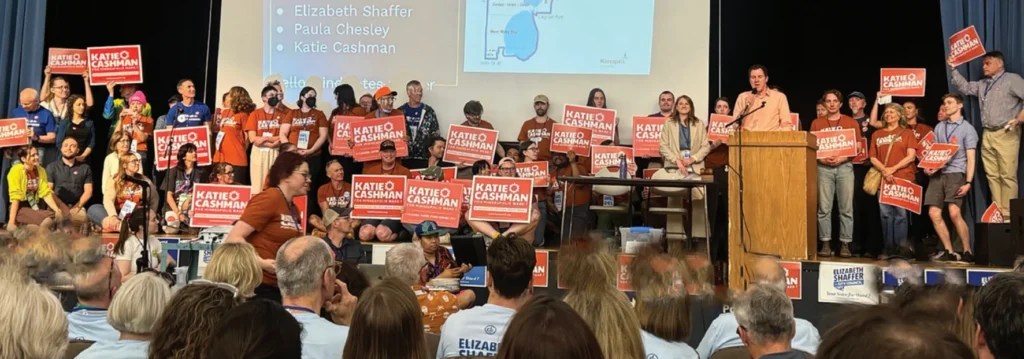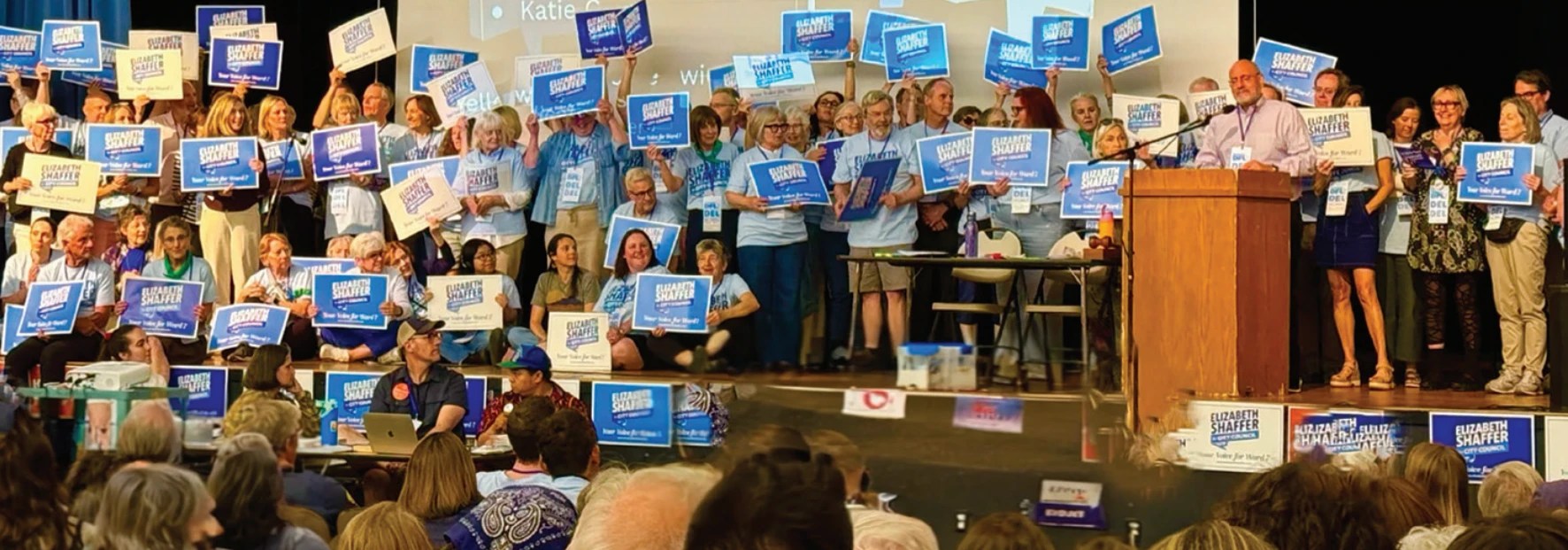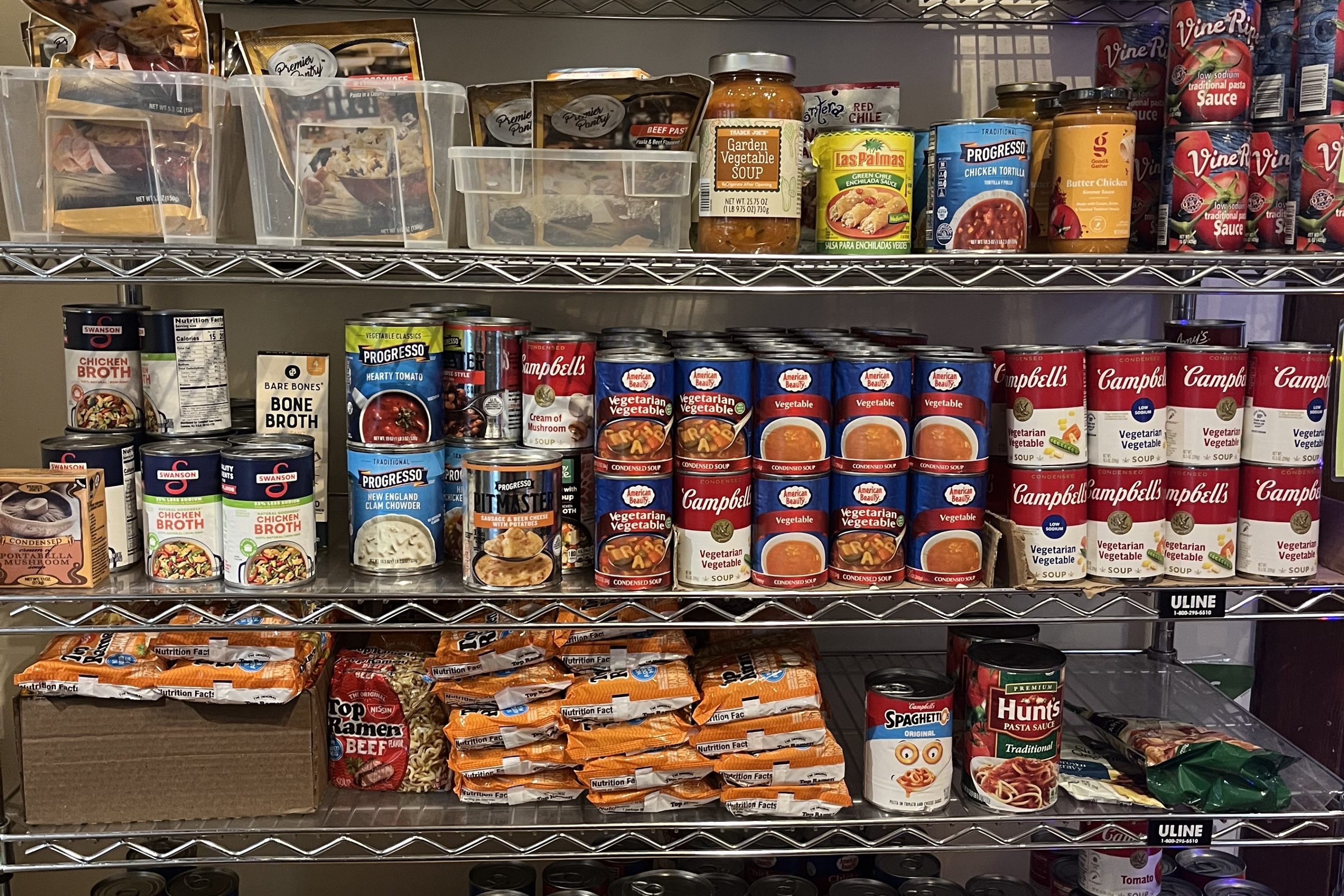In a nail-biter finish, Park Board Commissioner Elizabeth Shaffer scored the coveted DFL endorsement for Ward 7’s City Council seat at the party’s May 10 ward convention, held at Anwatin Middle School. All City Council seats, along with the mayor, are up for election this November.
On the second ballot, Shaffer cracked the 60% endorsement threshold, with 60.49% of the vote. In reaching her goal, Shaffer ended the campaign of first-time candidate Paula Chesley and dealt a major setback to incumbent Council Member Katie Cashman, who came just shy of the 40.01% mark necessary to end the convention with no endorsement.
Why are DFL conventions always on the nicest days of the year?
Per longstanding tradition, the convention took place on one of the most gorgeous weekend days of the spring, but the call of the wild did not deter hundreds of faithful DFLers from packing into the middle school auditorium for over six hours to advocate for their preferred candidates. Enthusiasm was high, and virtually no one left early.
For the uninitiated, ward conventions (there are 13!) determine who, if anyone, receives the DFL endorsement for City Council. Endorsements for mayor, Park Board and Board of Estimate and Taxation are decided at the DFL city convention, which will be held in July. For City Council races, the endorsement is significant because candidates who receive the endorsement typically go on to win in November.
The convention itself was called to order at 11 a.m., but after convention chairs, the parliamentarian, and ward delegates were elected, and rules agreed on, the main action didn’t start until shortly before 2 p.m.
First up, speeches! Each candidate was allowed 10 minutes, followed by a 30 minute question and answer panel, at which point the convention moved to the actual voting. All three candidates were introduced by surrogates before they spoke.
Paula Chesley
Chesley’s surrogate was Will Stancil, a noted online political commentator and recent Minnesota House candidate. Stancil said Chesley would be a strong advocate for revitalizing neighborhoods and local business districts, would take initiative, and be a good listener.

Chesley herself spoke of her history as a neighborhood organizer and advocate, and said she would work to promote economic vitality, promote public safety and affordable housing and provide prompt and attentive constituent services. Chesley made no bones about wanting the job — she stressed that no one had to ask her to run — and said she would bring a collaborative mindset and strong analytical skills to the job.
Katie Cashman
Cashman was introduced by Rep. Jamie Long, DFL floor leader for the Minnesota House. Long said his support for Cashman was driven by their shared concern about climate change, and that he had been impressed by Cashman’s work during last year’s legislative session, where she advocated for tax credits for commercial-to-residential building conversions and tax increment financing for small businesses, and supported ending a lawsuit challenging the Minneapolis 2040 plan.
Cashman said Ward 7 needed a council member who could unify, listen and deliver, and said she had met the moment. Cashman said she consistently advocated for “people-first” policies, and that public safety was her number one concern. She also touted commercial revitalization, particularly her championing of the council’s “vibrant storefronts” initiative, along with her support for renters’ rights and dignified housing for the unhoused. She concluded her comments by noting she was the only labor-endorsed candidate, and said she honored the “L” in “DFL.”
Elizabeth Shaffer
Shaffer was introduced by Andy Luger, who served as United States Attorney for Minnesota under Presidents Obama and Biden. Luger said that public safety was the top issue in this election, as it was during his tenure as U.S. Attorney. Having devoted much of his second term to fighting local violent crime, Luger said that collaboration was key to a multi-jurisdictional effort, but he described the City Council as the weak link in the chain. Luger was blunt in his assessment that Minneapolis needs a new City Council, and said Shaffer embodied the pragmatism and cooperation needed in that group.
When her turn came, Shaffer said that public safety and adequate police to allow for community policing was foundational. She also said that core city services needed to be prioritized, which included supporting both workers and businesses, as well as providing stable and supportive housing for all. Shaffer cited her work on revitalizing the Overlook Gardens, in Stevens Square, as an example of hands-on, collaborative leadership.
Q&A
The question-and-answer session covered a wide range of topics, including preferred bus and bike routes, business district revitalization, affordable housing, how to say no to allies, abortion access and support for labor. The three candidates were composed and direct, and the moderator kept the discussion moving at a brisk pace, packing considerable content into a relatively brief 30 minutes. The first question, by protocol, was whether the candidates would drop out if another obtained the endorsement. Chesley and Shaffer said they would, while Cashman said no.
The Voting
Then, at around 4 p.m., the votes finally began. In the first round of voting, with 370 delegates participating, the results were: Cashman, 142 votes (38.4%); Chesley, 23 votes (6.2%); Shaffer, 203 votes (54.9%), and “no endorsement,” 2 votes (0.5%). At the vote’s conclusion, Chesley — consistent with her answer during the Q&A — promptly announced that she was suspending her campaign, as she had failed to meet the required 15% viability threshold. She encouraged her delegates to stay and vote their conscience.
The second round of voting was narrow but decisive, with Chesley’s delegates appearing to shift almost entirely to Shaffer. With 367 delegates voting, Cashman stood pat at 142, while Shaffer’s vote increased to 222, putting her just above the 60% threshold required for endorsement. The auditorium promptly erupted in cheers from Shaffer supporters, which drowned out the final report that “no endorsement” had grown from 2 votes to 3.
A Mostly Peaceable Kingdom
From a decorum standpoint, the convention was a mostly peaceable kingdom. The crowd was highly energized and motivated, and there were the expected cheers and jeers, but the substantive work was largely driven by the agenda, “points of order” and “points of personal privilege.”
There were only two notable departures that I observed, one involving a heckler during the Q&A, and a more significant dust-up after the floor was frozen for the second vote, when a heated argument apparently developed between a Cashman supporter and at least one Shaffer supporter over floor access. In this latter instance, convention co-chair Natasha Docktor left no doubt as to her middle school teacher credentials, issuing the sternest of reproaches that such behavior was not acceptable and would not be tolerated.
In closing, I’ll invoke a point of personal privilege, having spent a beautiful spring day taking reams and reams of notes in a windowless room. Great credit is due to cochairs Tom Nordyke and Natasha Docktor, parliamentarian Kay Lewis, and the other volunteers who made this event happen.
It was a gathering of high energy and passion, and these volunteers managed it with good humor and firmness, allowing the messy business of democracy to proceed. And, finally, to the candidates: While they may not all receive our support, all deserve our thanks. Running for office is an act of real courage, and these candidates deserve respect for giving us a meaningful choice. Thank you.






